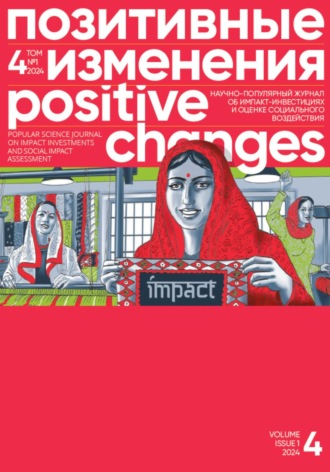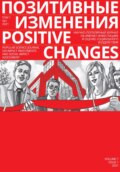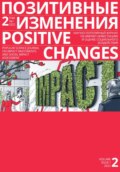
Редакция журнала «Позитивные изменения»
Позитивные изменения. Том 4, №1 (2024). Positive changes. Volume 4, Issue 1 (2024)
На данном этапе реализации проекта были отмечены следующие основные результаты проекта для местного сообщества:
• развитие добрососедства и взаимопомощи;
• саморазвитие, самореализация;
• расширение круга общения;
• новые знания и навыки;
• участие в благотворительности (в т. ч. волонтерство);
• улучшение эмоционального/психологического самочувствия.
Основные результаты для организаций – операторов и стейкхолдеров проекта, которые проводят мероприятия в ЦМС:
• дополнительные ресурсы (PR, реклама, место для проведения мероприятий, материалы для мероприятий);
• увеличение числа сторонников организации (участники, подписчики, партнеры);
• увеличение числа клиентов и заказов;
• повышение статуса/имиджа;
• расширение ЦА (привлечение новых участников);
• увеличение числа волонтеров;
• повышение доверия/лояльности к организации и ее ЦА;
• новый опыт и расширение возможностей для сотрудников организации;
• расширение возможностей сотрудников (бизнес) участия в социальных активностях;
• возможность реализовать свои инициативы (повысить самооценку);
• возможность привлечь дополнительное финансирование деятельности организации.
Основные результаты для директоров и сотрудников магазинов:
• улучшение настроения, положительные эмоции от работы и участия в мероприятиях ЦМС;
• увеличение трафика, рост выручки и показателя NPS магазина;
• сплочение рабочего коллектива;
• реализация своих талантов и идей;
• повышение лояльности к магазину и гордость за бренд.
Основные результаты для торговой сети:
• развитие кадрового потенциала сотрудников;
• повышение лояльности сотрудников и привлекательности компании как работодателя;
• восприятие торговой сети как социально ответственной компании;
• рост доверия и лояльности бренду.
Для такого проекта как ЦМС (сложносоставного, длительного, с прицелом на системность) модель B4SI кажется максимально адаптивной и для последующих этапов проекта. Кроме того, данная модель отличается емкостью и вариативностью оценки эффектов в части их интерпретации. Благодаря ей можно оценить сложный проект, в котором есть большое количество заинтересованных сторон, организаторов, разных целевых аудиторий, а также разного уровня вовлеченности участников.
Модель B4SI позволяет сделать описание возможных результатов социальных инвестиций, что также подходит для оценки ЦМС. Однако в дальнейшем не исключается использование дополнительных методов для более подробной оценки непосредственно эффектов, выведенных по модели B4SI. Такое отслеживание долгосрочных социальных результатов нуждается в накоплении эффектов от проекта и станет возможным на следующих этапах развития «Центров местного сообщества».
Assessing the Community Centers Project Using the B4SI Global Standard
Anna Guseinova
DOI 10.55140/2782-5817-2024-4-1-86-103

Local artist exhibitions, children’s workshops, author-led tours, festive gatherings, and much more – all within walking distance from home… Stores serve as hubs where the paths of diverse individuals intersect, thus serving as community centers. In our coverage, we delve into how the ongoing efforts of the community center network within these stores cultivate neighborliness and mutual aid, assess the project’s impact on local communities and businesses, and highlight significant outcomes for key project stakeholders.

Anna Guseinova
Social anthropologist, lead expert for the Community Centers project
PROJECT INFORMATION
The socially oriented Community Centers (CC) project kicked off in August 2021, initiated by the Pyaterochka retail chain. A part of the Pyaterochka with Care program, it aligns with X5 Group’s sustainable development agenda.
The project aims to alleviate feelings of loneliness, fear, and insecurity while mitigating the growing sense of alienation and social tension in communities. Each store becomes a local community hub, offering areas for residents to exchange notices and goods, alongside hosting regular social events open to all. These events, addressing themes such as ecology, healthy living, elder and child welfare, charity, territorial development, and cultural endeavors, align with the strategic objectives of the retail chain’s social responsibility program. The program requires approximately 4–6 events per year. Additionally, each area receives over 300 case studies via CC to implement local initiatives. These initiatives are organized by local activists, NGOs, social entrepreneurs, and store personnel. Besides establishing CC zones and organizing events, the project provides informational outreach to employees and residents, effectively turning each CC-designated store into a platform with informational and infrastructural capacity to boost social engagement, unite people and organizations, thereby amplifying local community strength.
CC establishment is not a one-off event but an ongoing, systematic initiative. By 2023, the program expanded from 350 to 1,350 stores across 32 regions (previously 9), engaging over 7 million individuals in socially relevant activities.
NGO partners for the CC project include charitable foundations such as Dobryi Gorod St. Petersburg and Good Stories, employing a community foundation model to drive community development, activate and support various initiatives by NGOs and individuals. The project provides partners with a unique avenue to fulfill their mission within the context of retail chain stores.
PROJECT GOALS:
• Social Objectives: Creating an environment that is good for local community development (spreading neighborly practices, promoting care among residents for each other and their surroundings, enabling self-development and fulfillment within proximity to home, etc).
• Business Objectives: Attracting new customers, enhancing loyalty among existing patrons, increasing employee satisfaction within the retail chain’s stores, and instilling pride in the company as a whole.
PROJECT AUDIENCE
The primary target audience comprises employees and visitors of the retail chain residing near its CC-designated stores. Additionally, numerous indirect stakeholders are involved, including:
• Local and federal NGOs operating within specific territories.
• Local activists.
• Governmental and municipal bodies and institutions.
• Other socially responsible businesses in the area open to partnership ventures.
• Cultural and educational institutions.
PROJECT STAGES
1. In 2020–2021, in collaboration with the Tsentsiper Bureau and You Social agency, the project concept was developed, leading to the implementation of two pilots – initially in 5, then in 50 stores across four regions: Moscow, Moscow Region, Krasnodar Region, and Sverdlovsk Region. Expert community managers (CMs) were brought in to spearhead the stores’ new role, aiding in center launches, introducing stakeholders to new resources, and educating store employees about the project’s mechanics and center capabilities.
2. A more extensive pilot took place in 2022–2023, involving 354 stores across 9 regions, organized into two clusters by operator funds. Each operator fund established a project support team comprising CMs, with one manager overseeing 25 stores.
Starting from spring 2023, the project entered its replication phase. Presently, it is operational in 1,350 stores spanning over 450 locations across Russia. According to a 2022 survey, 81 % of shoppers advocated for the project’s continuation, as CCs have become pivotal attractions and gathering spots for them.[90]
PROJECT ASSESSMENT METHODOLOGY
The comprehensive assessment of the project’s impact covered the following dimensions:
• The project’s contribution to the sustainable development of local communities, both socially and environmentally.
• Alignment with the business objectives of the retail chain and the overarching corporate social responsibility goals.
• The assessment study, conducted between November 2022 and January 2023, was led by experts from the “Charity Culture” Charitable Foundation and consisted of several key phases:
1. Desk Research (November 28, 2022 – December 5, 2022) involved familiarizing with project documentation, gathering information from open sources, and selecting a model for analyzing the project’s impact.
2. Qualitative Research (December 8, 2022 – January 12, 2023) comprised interviews and focus group discussions with key project stakeholders:
• Project coordinator from the retail chain;
• Project manager and methodologist from the retail chain, as well as leaders of partner organizations and project managers from Dobryi Gorod St. Petersburg and Good Stories;
Each CC-designated store into a platform with capacity to boost social engagement, unite people and organizations.
• Managers and mentors supporting community managers from two foundations (4 people);
• Community experts involved in the project’s pilot phase carried out without partner help (3 people);
• Community managers from partner funds (13 people);
• Store directors from two project clusters (11 people);
• Store employees (5 people);
• Stakeholders from local communities, such as event organizers at the CCs (11 people).
During the interviews, participants highlighted various successful initiatives and activities that held significance for the community. They also discussed initiatives that have been replicated across multiple stores and those with potential for future replication. Currently, the methodologist from the Dobryi Gorod St. Petersburg Foundation is curating a collection of successful practices and case studies for CC organizers in stores planning to join the project.
In some instances, the CC project achieved exceptional success due to pre-existing social networks and interactions within the community. In these cases, the CC served as a platform and catalyst for further interaction. Another key success factor for CMCs was the involvement of stakeholders, including organizations keen on engaging with the community and offering innovative formats and activities.
Figure 1. Components of the Business for Societal Impact Model

Source: B4SI. (2023). Retrieved from: https://b4si.net/. (accessed: 07.03.2024)
B4SI MODEL FOR ANALYZING PROJECT OUTCOMES
The B4SI (Business for Societal Impact) model, a global standard for corporate social impact assessment and management, formed the foundation for developing the project’s social and environmental impact assessment and management system.
The B4SI model empowers companies and their partners by providing impact information essential for various purposes, including:
• Ensuring a consistent approach to assessing contributions (inputs, various forms of investment, e.g. money, goods and services), outcomes, and impacts across company and partner initiatives;
• Informing strategic decisions regarding future directions, goals, and key performance indicators (KPIs) within the community context;
• Identifying and verifying outcomes for both the community and the company;
• Optimizing project operations and engaging new participants, including company employees;
• Communicating the results of community investments to key stakeholders;
The components of the B4SI model are summarized in Figure 1.
RESULTS OF THE COMPREHENSIVE ASSESSMENT
One of the primary objectives in analyzing the CC project was to delineate the core components of the B4SI model and devise recommendations for gathering data on the project’s products, outcomes, and impacts.
The fundamental information regarding the Inputs and Products segments resides within the reports provided by the project operators. Therefore, the initial focus was on structuring the available data and proposing a framework of outcomes and indicators for the Impact segment concerning the local community and environment.
1. Inputs
Given the CC project’s multifaceted nature and design, a comprehensive analysis of the resources invested in it necessitated considering more than just its financial aspect. To achieve this, insights were gathered during interviews concerning the resources of the retail chain utilized for CC operations.
The most substantial in-kind contribution to the CCs from the retail chain involves providing space within stores for CC equipment and activities. This contribution could be monetarily assessed based on allocated floor space and store premises’ rental rates. Additionally, the company not only funds CC launches but also provides them with printed materials for events and designs exhibitions within stores.
While no instances of such occurrences were identified during the focus group research, if goods were donated as part of any events, their value should be integrated into the in-kind inputs category, along with the value of publications, advertising space, or airtime on Voice of Pyaterochka radio, if allocated for project promotion.
When evaluating contributions in terms of time invested by store employees, consideration must be given to the value of directors’ and participating store employees’ time dedicated to CC activities and events. Typically, working hours are accounted for, and their value is calculated based on salary, including payroll insurance contributions.
Furthermore, it is advisable to factor in the company’s own expenses for managing the CC project, encompassing salaries or other compensation for the specialist coordinating the project from the trading company, along with employees from other departments involved in project management. These costs should also cover office equipment, communication, travel, and administrative expenses associated with project implementation, including consultant service fees. Such costs are counted separately if they are not part of the core project funding (which in turn is accounted as a financial support).
From a targeting perspective, the retail chain’s contributions to the CC project represent social investments, given that the project is initiated by the company itself, with clearly defined goals, objectives, and envisioned results, coupled with ongoing monitoring and analysis of their achievement.
Since community development and support are not explicitly outlined as separate themes in the B4SI model, this aspect could be classified under either the “Other” section or encompassed within all the themes presented in the model. The rationale is that a CC project can equally support activities across education, healthcare, economic development, and human welfare, depending on the needs of local communities and the involvement of active stakeholders engaged in various domains.
Regarding the project’s geographical scope, while classified globally under B4SI as projects in Europe, it is more fitting to analyze and manage results within the project by federal subjects of Russia. This approach stems from findings during the focus group research indicating that regional characteristics can influence project implementation nuances.
2. Products
Considering the design, goals, and objectives of the CC project within the B4SI model, it seems the most appropriate to account for the following products:
For the community:
• The number of individuals reached or supported: encompassing total store visitors and/or event participants informed about or directly involved in the CC project.
• Beneficiary types: participants in events catering to children, the elderly, socially disadvantaged individuals, people with disabilities, environmental or cultural events, etc. Additionally, separate consideration can be given to store visitors informed about CC work but yet to participate in specific events.
• The count of NGOs or other community organizations receiving support: commercial entities, NGOs (state and municipal institutions can be distinguished separately), initiative groups, individual entrepreneurs, activists, artists, etc.
• Other relevant indicators for the company based on project specifics: such as the number of activities across various topics and areas to comprehensively depict project scale and impact areas, and to draw insights on the most sought-after and relevant activities across different communities.
For business:
• Number of engaged employees: This metric encompasses the count of directors and store staff involved in the project, forming the backbone of CC operations.
• Number of reached clients/consumers: This indicator is best accounted for in community outcomes, as store guests become a pivotal group and beneficiaries within the CC project.
• Number of reached suppliers/distributors: This entails the tally of organizations within the value chain informed about or participating in the CC project, serving as promoters of events or engaging in other capacities.
• Other significant stakeholders engaged by the project: It’s crucial to consider potential and existing partnerships at the national level with companies and organizations not directly linked to the retail chain’s business but invested in local community development, engaging store visitors, and aligning with the CC project.
• Number of project publications: The CC project sets objectives and tracks the volume of publications leading up to and following CC events.
In analyzing co-financing for the CC project, a pro bono contribution towards CC-based events by stakeholder partners appears particularly relevant. This often translates into the cost of event hosts, trainers, or facilitators, as event materials are typically financed from the CC project budget. Additionally, the time dedicated by store directors and employees outside their regular work hours is a significant factor.
Focus group participants and interviewees also highlighted instances where charitable fundraisers were conducted as part of CC activities. Funds collected through such initiatives are also considered as products of the project.
3. Impact
As previously noted, the B4SI model considers products, outputs, and impacts for individuals and organizations directly affected by the project, excluding indirect beneficiaries. Key stakeholders of the CC project under this framework include:
• Representatives of local communities – store guests and event participants;
• Organizers of events based on the CC;
• Store directors and staff;
• The company as a whole.
All these stakeholders are crucial to the project’s success. The CC cannot thrive without the involvement of store managers and staff. Moreover, meaningful and relevant activities heavily rely on local stakeholders, while community building is impossible without store guests and event participants. Thus, the project’s complexity lies in balancing the interests of at least three key stakeholders.
COMMUNITY OUTCOMES
While the CC primarily serves as a community activity, research suggests it also facilitates community development. Often, individuals view stores not just as shopping venues but also as spaces for engagement, charity, social connections, and support. Through the project, communities, environments, and stores become more interconnected, and the company’s brand gains social significance among customers and employees alike.
Based on insights from CMs, store directors, and employees, it is evident that CCs bring about noticeable changes in store guests’ experiences. According to the B4SI model, these changes need to be characterized based on their impact depth and nature.
Overall, observations from CMs, store directors, staff, and event organizers indicate a positive reception towards CC activities among guests, who show interest in participating. Some employees and CMs even note guests’ willingness to contribute to these activities. Thus, stores are gradually evolving into places where people engage in meaningful events and acts of kindness.
Project participants point out a distinct difference in community involvement in CCs between large cities and small towns. In rural settlements lacking cultural centers, libraries or public spaces, the store hosting a CC becomes the only spot for the residents to gather and have a chat or do something together. However, these communities already have established themselves.
Figure 2. Community Stakeholder Map for the CC Project

The study explored the initial assumption that CCs might appeal more to specific target groups like children, parents, older adults, or youth. However, participants noted that no particular group dominates. Participation often depends on the store’s location and the activities organized by local organizations or individuals. For instance, the presence of childcare facilities near the store tends to attract more children and parents to CC activities.
Based on feedback from focus group participants, we have made the list of the primary outcomes that community members achieve through the project:
• Cultivation of neighborly bonds and mutual support;
• Personal growth and fulfillment;
• Broadened social circles;
• Acquisition of new knowledge and skills;
• Active involvement in charity, including volunteering;
• Improved emotional and psychological well-being.
This comprehensive list has become the basis for the creation of a stakeholder map titled “Community” (Figure 2).
PROJECT IMPACT
The CC project’s impact on organizations was clarified through focus groups involving stakeholders who organize CC events. The discussions revealed positive effects across various domains outlined in the B4SI model.
Presently, the project organizes events involving:
• non-profit organizations;
• municipal budgetary organizations;
• commercial enterprises;
• civic-minded individuals.
In numerous instances, events are conceived and executed by the CMs themselves, with some initiatives even managed by store directors.
The task of sourcing and engaging event organizers largely falls to the CMs, primarily through informational outreach and face-to-face interactions. The selection of organizers often hinges on their proximity to the store, involving organizations operating within the city, town, or region. Collaborations with prominent NGOs at the regional or federal level, such as the Love Syndrome, Downside Up, and Joy of Old Age foundations, also take place occasionally. Additionally, CCs actively participate in large-scale network campaigns organized by X5 Group in collaboration with major partners.
Event formats span exhibitions, workshops, lectures, concerts, book exchanges, informational campaigns, etc. The choice of a particular CC’s format depends largely on store capacity and staff availability.
According to many focus group participants, events catering to children and the elderly gain the most traction. However, the theme and target demographic often align with the event organizer’s mission and audience.
Figure 3. “Event Organizers” Stakeholder Map

Event organizers participating in focus groups highlighted several key outcomes stemming from their involvement in the project:
• Access to additional resources such as PR, advertising, venues, and event materials;
• Expanded support base for the organization, including participants, subscribers, and partners;
• Increased customer engagement and sales;
• Enhanced organizational image and status;
• Widened customer base, attracting new participants;
• Growth in volunteer numbers;
• Increased trust and loyalty among customers and stakeholders;
• New experiences and empowerment opportunities for staff;
• Greater opportunities for staff to engage in social initiatives;
• A platform to materialize personal initiatives, improving self-esteem;
• Potential for securing additional funding.
This comprehensive list has become the basis for the creation of a stakeholder map titled “Event Organizers” (Figure 3).
Speaking of environmental impact, he B4SI model incorporates environmental enhancements resulting from backing environmental projects, along with positive shifts in behavior towards ecological concerns and sustainable consumption. During focus group sessions, participants unanimously emphasized the CC’s role in hosting environmental activities, mainly aimed at altering people’s ecological behaviors, encompassing waste segregation, recycling, item reutilization, etc.
To quantify the project’s environmental footprint, the model should indicate the proportion of environmental initiatives within the CC’s overall event portfolio. Additionally, specifying the number of such events and the allocated budgetary share would be beneficial.
The impact of the CC project on business, as per the B4SI model, is assessed across the “employees” and “business as a whole” dimensions:
Assessing the broader business impact of the CC project entailed a thorough examination of data acquired from focus groups and interviews. Noteworthy positive transformations include:
• Human Resources Development: An increase in employee loyalty among those engaged in the CC project, rendering stores more appealing as workplaces;
• Enhanced Stakeholder Relations/
Perception: Insights from store directors and staff during focus groups indicate increased loyalty and favorable sentiments among store guests. They now perceive Pyaterochka not merely as a seller of essential goods but also as a socially conscientious entity invested in community welfare;
• Business Advancement: Focus group participants report an uptick in NPS (Net Promoter Score) and foot traffic in stores attributable to the CC initiative.
As the CC model proliferates, it is possible that additional favorable business outcomes will emerge over time.
INVOLVEMENT OF DIRECTORS AND STAFF IN CC INITIATIVES
It’s crucial to also look into the evolving dynamics experienced by store directors and staff in connection with the CC project.
The level of motivation exhibited by directors and staff to participate in the project serves as a pivotal factor shaping the initiative’s success and efficacy at individual stores.
Director involvement in CC events varies from minimal to maximal engagement. Minimal engagement means authorizing project activities without active participation, whereas maximal engagement involves directors managing project initiatives, actively organizing events during and outside regular hours (often on weekends and evenings), and rallying store employees.
In isolated cases, focus group participants highlighted instances where store directors not only failed to support project implementation but also impeded the CM’s work. This is due to the fact that sometimes store directors were not motivated to participate in the project, since they did not have full information about the project in general, its goals and objectives, features and benefits of implementation, and most importantly about the project now being an integral part of the Pyaterochka operations, and not just some kind of an outside initiative. Consequently, a strategic decision was made to enlist stores in the project only at the behest of their staff, accompanied by comprehensive training for directors and staff, facilitating knowledge exchange and the dissemination of best practices from the CC.
At its core, the project is based on voluntary participation, driven by individuals’ independent desire to partake. Our objective lies in identifying key project stakeholders – individuals poised not only to participate actively but also to champion and instigate events among employees, partners, and store guests.
Employee involvement in the project can range from the oversight of a dedicated project administrator responsible for event coordination to the full engagement of the entire staff. The latter actively contributes ideas, assists in event preparation and execution, aids in CC promotion and guest outreach, contributes to store aesthetics, and participates in employee competitions, sometimes bringing their children to events.
This diversity of project activities empowers employees to explore avenues beyond their usual duties, showcasing their talents, creativity, compassion, and altruism. It is an opportunity for personal fulfillment, enabling some to make long-held aspirations a reality. In numerous instances, store directors noted that heightened employee engagement in events provided for better team cohesion.
With the project’s evolution within stores – engaging CMs, equipment installation, and event hosting – employee interest, motivation, good emotions and satisfaction from the ability to do good have surged. It was the most prominent at moments when teams began to witness the tangible impact of their participation – be it positive feedback, interested and supportive clients, increased footfall, or heightened retail revenue and NPS.
In the future, if the project is integrated into stores operating under the “partner director” model, the surge in footfall and NPS could directly impact the income levels of both directors and employees through annual payouts and bonuses. This, in turn, could serve as a significant motivational factor, encouraging store teams to actively engage in the project. Two years ago, the company embarked on instilling a partnership culture into its management framework – a paradigm where each employee is directly interested in the company’s outcomes, as if it were their own enterprise. Under the Partner Store Director program, participants are afforded greater autonomy, equipped with additional tools and on-ground authority, essentially motivating store directors to develop the business as if they were partners. Consequently, directors operating under this model now have the capacity to directly influence business outcomes, enhancing their professional skills and increasing both personal and employee earnings through year-end bonuses tied to store revenue.
Furthermore, focus group research underscored the project’s capacity to inject variety into mundane routines, elevate employee morale, and facilitate creativity, thereby nurturing loyalty not only among store patrons but also among employees and prospective applicants.
Figure 4. “Store Directors and Employees” Stakeholder Map

Thus, the project’s primary outcomes for directors and staff are:
• Improved morale and positive emotions stemming from involvement in CC events;







